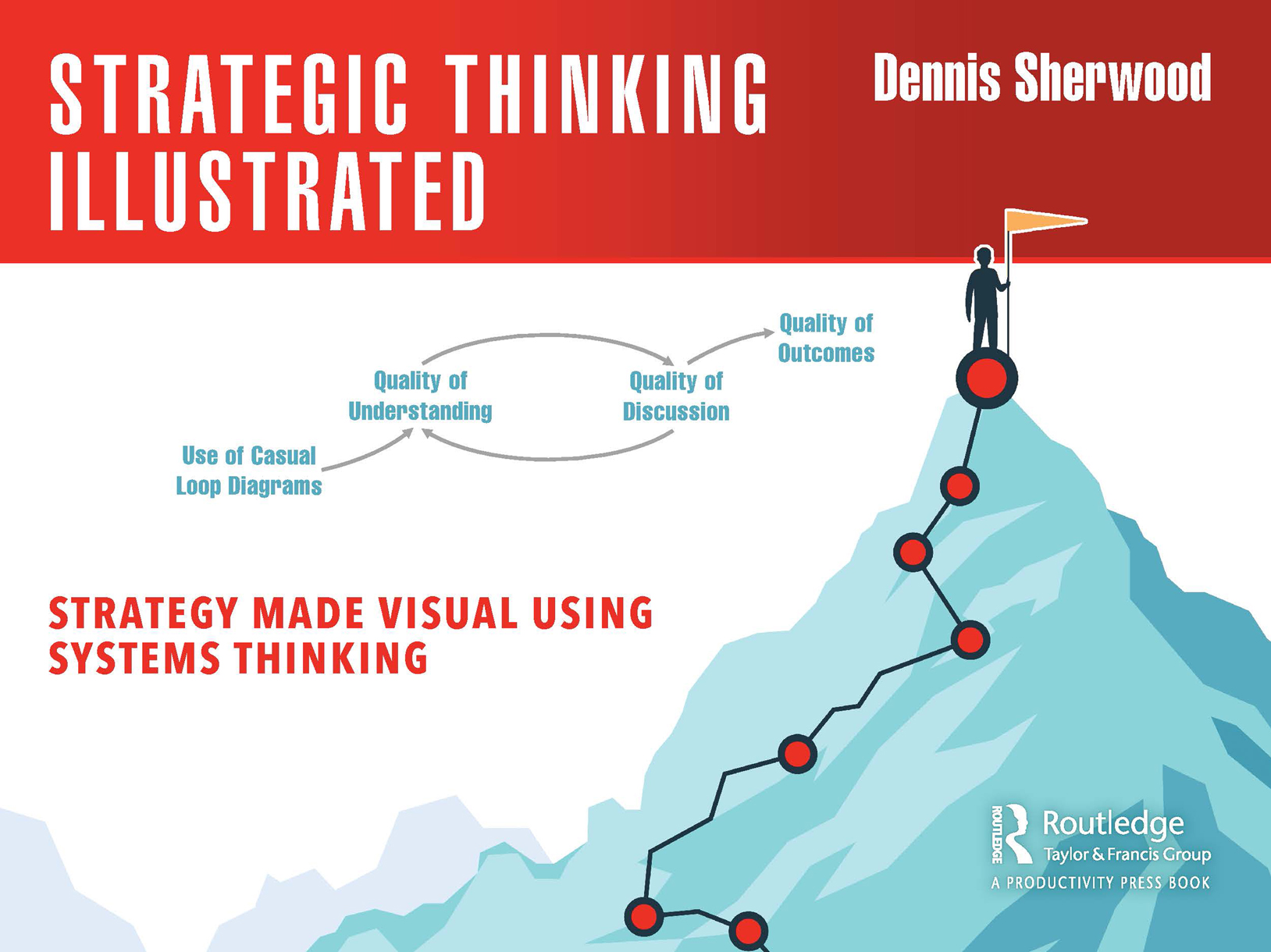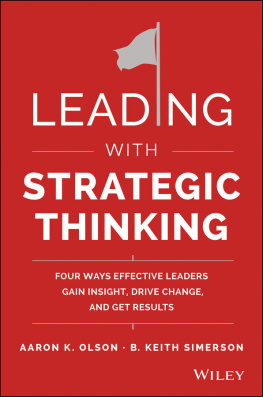Dennis Sherwood - Strategic Thinking Illustrated
Here you can read online Dennis Sherwood - Strategic Thinking Illustrated full text of the book (entire story) in english for free. Download pdf and epub, get meaning, cover and reviews about this ebook. year: 2023, publisher: Taylor & Francis (Unlimited), genre: Romance novel. Description of the work, (preface) as well as reviews are available. Best literature library LitArk.com created for fans of good reading and offers a wide selection of genres:
Romance novel
Science fiction
Adventure
Detective
Science
History
Home and family
Prose
Art
Politics
Computer
Non-fiction
Religion
Business
Children
Humor
Choose a favorite category and find really read worthwhile books. Enjoy immersion in the world of imagination, feel the emotions of the characters or learn something new for yourself, make an fascinating discovery.

- Book:Strategic Thinking Illustrated
- Author:
- Publisher:Taylor & Francis (Unlimited)
- Genre:
- Year:2023
- Rating:3 / 5
- Favourites:Add to favourites
- Your mark:
- 60
- 1
- 2
- 3
- 4
- 5
Strategic Thinking Illustrated: summary, description and annotation
We offer to read an annotation, description, summary or preface (depends on what the author of the book "Strategic Thinking Illustrated" wrote himself). If you haven't found the necessary information about the book — write in the comments, we will try to find it.
Strategic Thinking Illustrated — read online for free the complete book (whole text) full work
Below is the text of the book, divided by pages. System saving the place of the last page read, allows you to conveniently read the book "Strategic Thinking Illustrated" online for free, without having to search again every time where you left off. Put a bookmark, and you can go to the page where you finished reading at any time.
Font size:
Interval:
Bookmark:

This book is about the behaviour of systems. Systems are important, for we interact with them all the time, and many of the actions we take are influenced by a system for example, the system of performance measures in an organisation influences, often very strongly, how individuals within that organisation behave. Furthermore, sometimes we are involved in the design of systems, as is any manager contributing to the definition of what those performance measures might be. That manager will want to ensure that all the proposed performance measures will drive the right behaviours rather than (inadvertently) encouraging dysfunctional game playing, and so anticipating how the performance measurement system will work in practice is a vital part of a wise design process.
Some of the systems with which we interact are local, such as your organisations performance measurement system. Some systems, however, are distant, but nonetheless very real, such as the healthcare system, the education system, the legal system and the climate system. Systems therefore exist on all scales, from the local to the global. And all systems are complex, some hugely so. Thats why understanding how systems behave can be very helpful.
Systems are complex for two main reasons. First, the manner in which they behave over time can be very hard to anticipate and anticipating the future sensibly is of course a key objective of management. Second, the entities within a system can be connected together in very complex ways, so that an intervention here can result in an effect there, perhaps a long time afterwards. Sometimes this can be surprising, and so we talk of unintended consequences but this is of course a euphemism for because I didnt understand how this system behaves, I had not anticipated that.
Systems thinking, the subject matter of this book, is the disciplined study of systems, and causal loop diagrams the pictures of this picture book are a very insightful way to represent the connectedness of the entities from which any system is composed, so taming that systems complexity.
First published 2023
by Routledge
605 Third Avenue, New York, NY 10158
and by Routledge
4 Park Square, Milton Park, Abingdon, Oxon, OX14 4RN
Routledge is an imprint of the Taylor & Francis Group, an informa business
2023 Dennis Sherwood
The right of Dennis Sherwood to be identified as author of this work has been asserted by him in accordance with sections 77 and 78 of the Copyright, Designs and Patents Act 1988.
All rights reserved. No part of this book may be reprinted or reproduced or utilised in any form or by any electronic, mechanical, or other means, now known or hereafter invented, including photocopying and recording, or in any information storage or retrieval system, without permission in writing from the publishers.
Trademark notice: Product or corporate names may be trademarks or registered trademarks, and are used only for identification and explanation without intent to infringe.
ISBN: 978-1-032-30234-8 (hbk)
ISBN: 978-1-032-30233-1 (pbk)
ISBN: 978-1-003-30405-0 (ebk)
DOI: 10.4324/9781003304050
Typeset in Garamond
by codeMantra
This is a book about thinking strategically using systems thinking. Put simply, systems thinking means seeing the world as a complex, interconnected place. When Dennis Sherwood and I first got interested in systems thinking that was still a novel insight. It is noticeable and welcome that today the insight is mainstream. I remember doing some work on the operation of the Accident and Emergency department in a London hospital in the 1990s and realising that charging in with My goodness, have you people realised that you are living in a complex, interconnected system?! would not really get you very far. They knew that already. People in health care have that insight because they are clever and because they spend their lives dealing with one of the most complex, interconnected systems around: the human body. But that insight is not enough. Although it has become mainstream almost to the point of management clich that is not the end of the story.
The issue today is what to do with that insight. What people need is a vehicle that helps them do something with that idea, a tool that helps them move forward. Tools are fine things and we should never be ashamed of reaching for them. The human mind can imagine that it would be useful to fasten two pieces of wood together with a nail. We are also bright enough to know that trying to bring this about with just your fist will just produce a bloody mess. So we invented the hammer. It is a good tool to reach for. So is systems thinking.
The term systems thinking means different things to different people. It is sometimes used for the range of approaches that make up the field of Systems Science. Peter Checklands Soft Systems Methodology fits with this, as do other approaches that aim to take a holistic view of the world. However, the type of systems thinking discussed here derives from System Dynamics, the creation of Prof. Jay W. Forrester. This concerns itself with causal connections, accumulations and feedback loops and how these can be used to explain how things evolve over time.
Research tells us that, unassisted, people are not that good at thinking about long chains of consequences, of pondering feedback effects, of considering what will happen if they take a certain course of action, enact a given policy. Strategic thinking becomes counter-intuitive, challenging, overwhelming. That is where systems thinking comes in. That is where this book comes in. Systems thinking is the vehicle that people need, the tool that converts the insight of complexity and inter-connectedness into an approach that is practical and helpful and positive.
If you have a suspicion that it is all getting a bit complex, that holding inside your head all the different connections that you think might be there in the world is making your brain feel fluffy, then this book is for you. Simply getting a blank piece of paper and mapping out your ideas gives you a picture of what you are thinking. In cognitive terms it acts as a form of virtual memory: you can work on one part of the map, then shift your attention to another part, sure in the knowledge that everything is still there, recorded and ready to be gone back to. You can think about long chains of effects. You might even discover unintended consequences of an action or policy. (Because in systems thinking there are no side effects; rather there are effects that you had not anticipated.) The map can help with that. It can also give you some help with thinking about how a system will evolve over time, what trajectories the value of the variables will have as time flows forward. To do that you need to find the reinforcing and balancing feedback effects and to puzzle out how they interact and drive behaviour. This is the route to strategic thinking.
At some point a qualitative map may not do all that you need. A model with numbers, a model that allows you to press , a model that simulates the consequences of your assumptions might be useful. Systems thinking includes that too. Simulation modelling requires more work, more effort. But as our colleague Kim Warren likes to say, what is a senior decision-makers job if not to work hard, to put serious effort into choosing a course of action? Something that will rigorously and unambiguously deduce the consequences over time of your assumptions is a good thing to have to hand. Indeed, I would add What if? to Kiplings six honest serving men to form a septuplet.
Next pageFont size:
Interval:
Bookmark:
Similar books «Strategic Thinking Illustrated»
Look at similar books to Strategic Thinking Illustrated. We have selected literature similar in name and meaning in the hope of providing readers with more options to find new, interesting, not yet read works.
Discussion, reviews of the book Strategic Thinking Illustrated and just readers' own opinions. Leave your comments, write what you think about the work, its meaning or the main characters. Specify what exactly you liked and what you didn't like, and why you think so.










